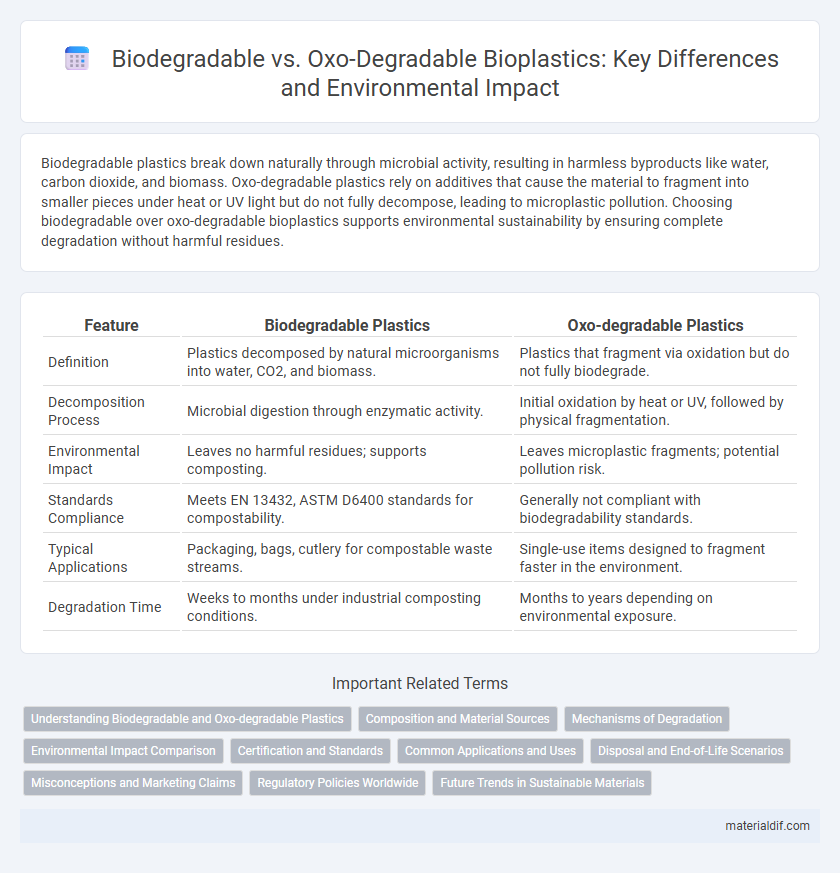Biodegradable plastics break down naturally through microbial activity, resulting in harmless byproducts like water, carbon dioxide, and biomass. Oxo-degradable plastics rely on additives that cause the material to fragment into smaller pieces under heat or UV light but do not fully decompose, leading to microplastic pollution. Choosing biodegradable over oxo-degradable bioplastics supports environmental sustainability by ensuring complete degradation without harmful residues.
Table of Comparison
| Feature | Biodegradable Plastics | Oxo-degradable Plastics |
|---|---|---|
| Definition | Plastics decomposed by natural microorganisms into water, CO2, and biomass. | Plastics that fragment via oxidation but do not fully biodegrade. |
| Decomposition Process | Microbial digestion through enzymatic activity. | Initial oxidation by heat or UV, followed by physical fragmentation. |
| Environmental Impact | Leaves no harmful residues; supports composting. | Leaves microplastic fragments; potential pollution risk. |
| Standards Compliance | Meets EN 13432, ASTM D6400 standards for compostability. | Generally not compliant with biodegradability standards. |
| Typical Applications | Packaging, bags, cutlery for compostable waste streams. | Single-use items designed to fragment faster in the environment. |
| Degradation Time | Weeks to months under industrial composting conditions. | Months to years depending on environmental exposure. |
Understanding Biodegradable and Oxo-degradable Plastics
Biodegradable plastics break down naturally through microbial activity into water, carbon dioxide, and biomass within a specific timeframe, minimizing environmental impact. Oxo-degradable plastics contain additives that promote fragmentation under heat or UV light, resulting in microplastics rather than complete mineralization. Understanding the differences is crucial for selecting sustainable materials that align with environmental regulations and waste management practices.
Composition and Material Sources
Biodegradable plastics are primarily composed of natural polymers such as starch, cellulose, and polylactic acid (PLA) derived from renewable resources like corn and sugarcane. Oxo-degradable plastics consist of conventional petrochemical-based polymers like polyethylene enhanced with metal additives such as manganese or iron to promote oxidative degradation. The key distinction lies in biodegradable plastics' ability to break down into biomass through microbial action, whereas oxo-degradable plastics fragment into microplastics under environmental conditions without complete mineralization.
Mechanisms of Degradation
Biodegradable plastics break down through microbial activity, where enzymes convert polymer chains into water, carbon dioxide, and biomass under aerobic or anaerobic conditions, ensuring complete assimilation into the environment. Oxo-degradable plastics undergo an initial oxidative fragmentation initiated by UV light or heat, resulting in smaller plastic fragments; however, these fragments often persist in the environment as microplastics due to incomplete biodegradation. The distinct degradation pathways highlight the environmental impact difference, with biodegradable plastics offering a more sustainable solution by fully mineralizing into natural compounds.
Environmental Impact Comparison
Biodegradable plastics break down naturally through microbial activity, resulting in minimal environmental impact and reduced microplastic pollution. Oxo-degradable plastics fragment into smaller pieces through oxidation but do not fully decompose, contributing to persistent microplastic contamination in ecosystems. The environmental advantages of biodegradable plastics include enhanced soil health and reduced harm to marine life compared to oxo-degradable materials, which may exacerbate plastic pollution.
Certification and Standards
Biodegradable plastics are certified under standards such as ASTM D6400 and EN 13432, which ensure complete breakdown within specific timeframes and conditions, promoting environmental safety. Oxo-degradable plastics lack internationally recognized certification, as their fragmentation process can lead to microplastic pollution, raising environmental concerns. Certifications like OK Compost and TUV Austria's Seedling highlight biodegradable plastics' compliance with stringent biodegradability and eco-toxicity criteria.
Common Applications and Uses
Biodegradable plastics are widely used in compostable food packaging, agricultural films, and disposable tableware, enabling complete breakdown through microbial action. Oxo-degradable plastics find applications in single-use bags, packaging films, and agricultural mulch, where additives promote fragmentation under UV light and oxygen exposure but may leave microplastic residues. The selection between biodegradable and oxo-degradable materials depends on end-of-life environmental impact and regulatory compliance in sectors like foodservice, agriculture, and retail packaging.
Disposal and End-of-Life Scenarios
Biodegradable plastics break down into natural components through microbial activity in composting or soil environments, resulting in minimal environmental impact. Oxo-degradable plastics undergo fragmentation into microplastics under UV light or heat but do not fully biodegrade, posing long-term pollution risks. Proper disposal of biodegradable plastics in industrial composting facilities enhances degradation, whereas oxo-degradable plastics often persist in landfills, complicating end-of-life waste management.
Misconceptions and Marketing Claims
Biodegradable plastics break down naturally through microbial activity, while oxo-degradable plastics fragment via oxidation but do not fully biodegrade, often leading to microplastic pollution. Marketing claims frequently conflate oxo-degradable plastics with compostable or fully biodegradable alternatives, causing confusion among consumers about environmental benefits. Misconceptions arise as oxo-degradable products may persist in ecosystems, undermining true sustainability goals.
Regulatory Policies Worldwide
Regulatory policies worldwide increasingly favor biodegradable bioplastics over oxo-degradable alternatives due to environmental impact concerns. The European Union and numerous countries have banned or restricted oxo-degradable plastics, citing their incomplete degradation and potential microplastic pollution. Compliance with international standards, such as ASTM D6400 and EN 13432, is essential for biodegradable bioplastics to enter markets embracing sustainable packaging regulations.
Future Trends in Sustainable Materials
Future trends in sustainable materials highlight a clear shift from oxo-degradable plastics toward fully biodegradable bioplastics due to increasing environmental regulations and consumer demand for eco-friendly alternatives. Biodegradable materials derived from renewable resources like polylactic acid (PLA) and polyhydroxyalkanoates (PHA) demonstrate greater potential for complete decomposition without harmful microplastic residue. Innovations in enzymatic degradation and composting technologies are accelerating the adoption of biodegradable bioplastics in packaging and agriculture, positioning them as key players in a circular economy.
Biodegradable vs Oxo-degradable Infographic

 materialdif.com
materialdif.com